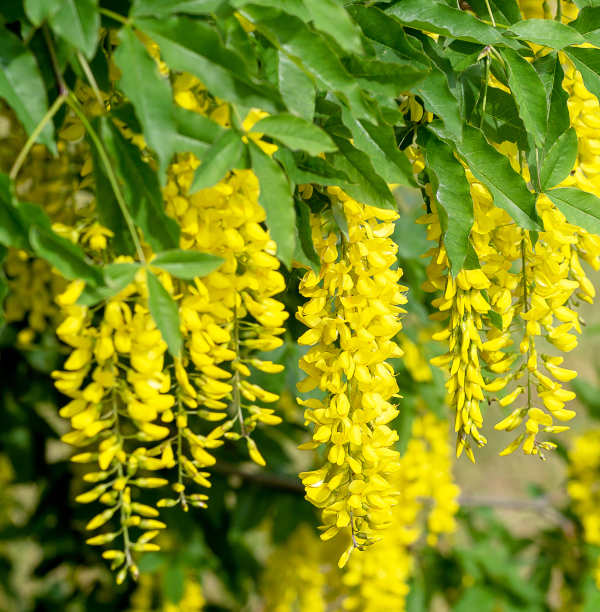How to grow Laburnum
Also known as golden chain, golden rain, or bean trefoil, Laburnum is a deciduous tree from the woodlands and mountains of Europe and west Asia. It is grown for its showstopping display of hanging, yellow, wisteria-like flowers which bloom in May and June, though its clover-like, intensely green foliage is also an attractive feature.
Growing best in a moderate climate, Laburnum is perfectly suited to life in the UK and one of the nation’s favourite garden trees. There are two species: Laburnum anagyroides (common laburnum) and Laburnum alpinum (scotch laburnum), with a hybrid of the two, Laburnum x watereri ‘Vossi’, being a widely grown form.
It is important to note that all parts of laburnum are toxic if ingested, particularly the seedpods. Keep away from pets and children, and always wear gloves when handling.
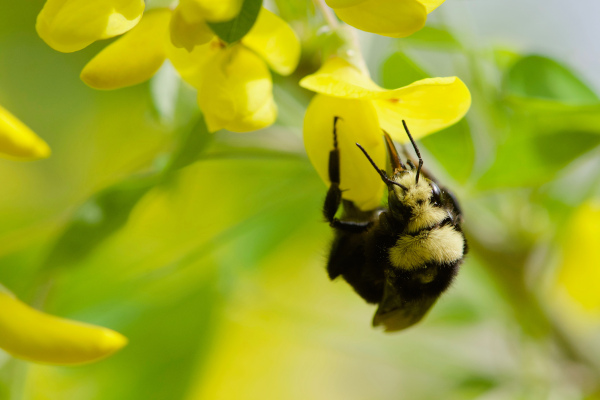
Zantedeschia is a genus of flowering plants from the family Araceae and is native to southern Africa. With a rich history dating back to the Ancient Romans, these deciduous or semi-evergreen perennials have been used as a symbol of celebration. Zantedeschia was Named after Professor Giovanni Zantedeschia, an Italian botanist.
There are two main forms of Zantedeschia: hardy and tender. Hardy forms of the plant can be grown outdoors, enjoy moist soil and full sun or partially shaded conditions - these are known as Arum lilies. Tender forms of Zantedeschia prefer being grown in containers or pots and should be brought inside over the winter - these are known as Calla lilies.
With tuberous flora in all colours from whites, yellows and oranges to deep reds and purples, Zantedeschias are not to be overlooked in any garden, as long as they have sufficient sunlight to grow in.
Ready to learn more about growing Zantedeschia? Read on for all there is to know...

Key Information
Soil pH
Position
Hardiness

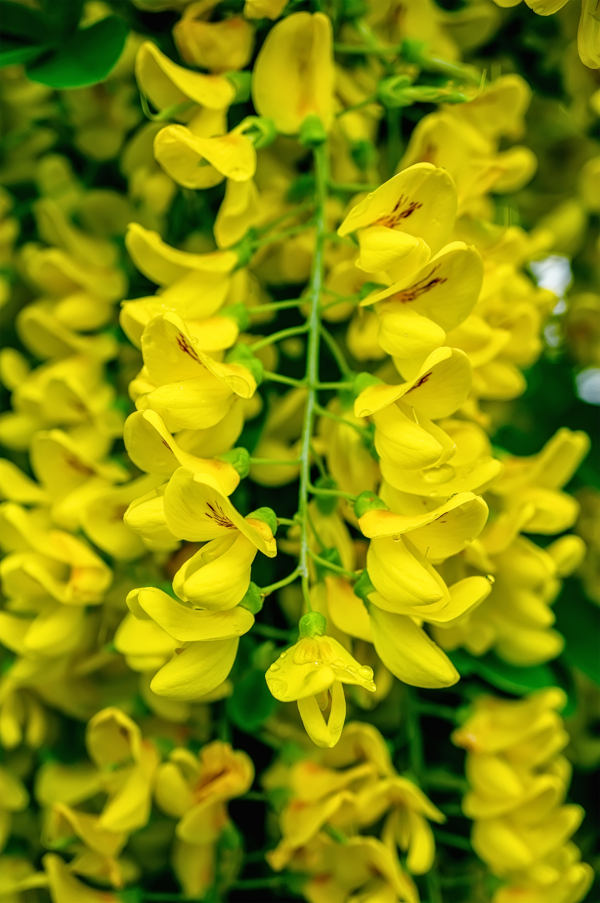
Where & when to plant Laburnum
Position - Ideally full sun, or, if you’re prone to very hot summers, light dappled shade. Avoid frost pockets if you get late frosts, as the flower buds can be damaged by freezing temperatures.
Soil - Will grow in any soil as long as it is not overly acidic or alkaline. Avoid anywhere prone to waterlogging (a sure fire way to kill this tree off).
Flowering Period - Late spring to early summer.
Hardiness - Hardy, with a rating of H6. This means able to withstand temperatures to between -15 and -20°C.
Laburnum can be bought as both container-grown plants and in bare root form.
Container-grown plants tend to be available for most of the year, though best results come from planting in autumn or spring. An autumn planting is suitable for those gardening in mild conditions (and broadly speaking, this is the southern half of the UK). For those liable to cold winters, it is best to wait until spring (generally the northern half of the UK). Try to avoid planting in summer as woody plants struggle to establish well from this.
Bare roots are available during the dormant period, usually between October and March. These should be planted straight away, though it is important to avoid frozen or waterlogged conditions. If you need to wait for more favourable conditions to arrive, bareroots can be ‘heeled in’ (temporarily planted in more friable soil or a bucket of compost) or soaked in water for a few days to keep the roots from drying out.
When it comes to choosing a spot, laburnum can be grown as a freestanding specimen tree, perhaps in a lawn or large border. It is also suitable for training against a wall (its roots are non-invasive and won’t damage foundations), or on a ‘walk through’ structure such as a pergola, arch, or walkway, where its hanging blooms will dangle above head height. Perhaps the most famous example of this is the laburnum avenue at Bodnant Garden in Wales.
While laburnum is naturally a medium sized tree which is happiest in open ground, there are a number of dwarf forms which may be suitable for a container. These include ‘Yellow Rocket’ and ‘Pendulum’.
How to plant Laburnum
Water container-grown plants well and allow to drain before planting. Soak the roots of bare root plants in a bucket of water for a few hours prior to planting.
- For trained forms, install support prior to planting.
- If you are planting into grass, remove a circle of grass at least 1m in diameter.
- Dig the soil area over, removing any large stones and weeds and breaking up any lumps. Mix in a generous amount of organic matter such as manure or garden compost (this is especially needed at the base of walls, where the soil can be dry and poor).
- Rake level and firm with your heels. Rake level again.
- Now dig the planting hole, a good tip being to aim for twice the size of the roots. If you are planting against a wall, plant the laburnum 30cm away from its base.
- Place the plant in the hole, ensuring the top of the root ball sits level with the surface of the soil. To high and the roots can dry out, too low and the stem can rot.
- Backfill with soil and firm in gently with your foot.
- Soak well with water.
- Mulch around the base with well-rotted organic matter such as manure or garden compost.
- For trained forms, tie in any suitable ‘main’ shoots to the support, pruning all other growth back to three to four buds. See our ‘Pruning’ section below for the next steps.
- For planting in containers (remember, dwarf forms only), first choose an appropriately sized pot at least 45cm across. You’ll need to repot into a slightly larger pot every few years. Always ensure there are plenty of drainage holes in the bottom.
- It can be a good idea to fill and plant your pot in situ to save yourself the trouble of moving it once full.
- Use a good quality potting compost with plenty of horticultural grit mixed in, and, if not already present in the compost (check the description on the bag) some slow-release fertiliser granules.
- Start by partially filling the pot with compost; enough so that when placed on it the top of the roots sit about 3cm lower than the top of the pot.
- Infill all the space surrounding the roots with compost, firming down with your fingers then adding a little more so the plant is held tight. Again, remember to ensure the graft union sits just above the surface of the compost.
- Pick up the pot (if you can!) and lightly tap on the potting bench or ground a few times to help further settle the compost around the plant.
- Soak well with water.
- A mulch with horticultural grit will look attractive and help to prevent a ‘cap’ or crust forming on the top of the compost (something container plants can suffer due to the artificial nature of their watering).
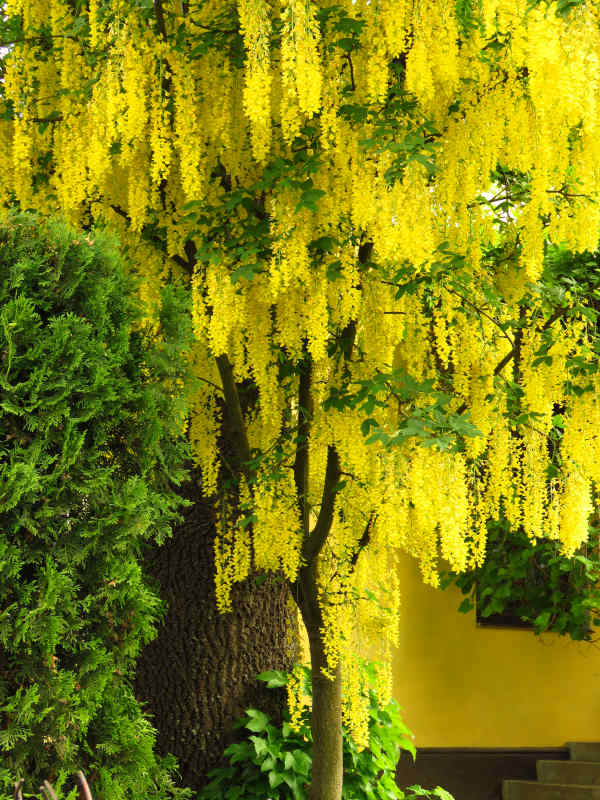
What to plant with Laburnum
The bright yellow of laburnum flowers looks spectacular contrasted against various shades of blue. Go for those in bloom during the same late spring to early summer period, such as allium, wisteria, and nepeta.
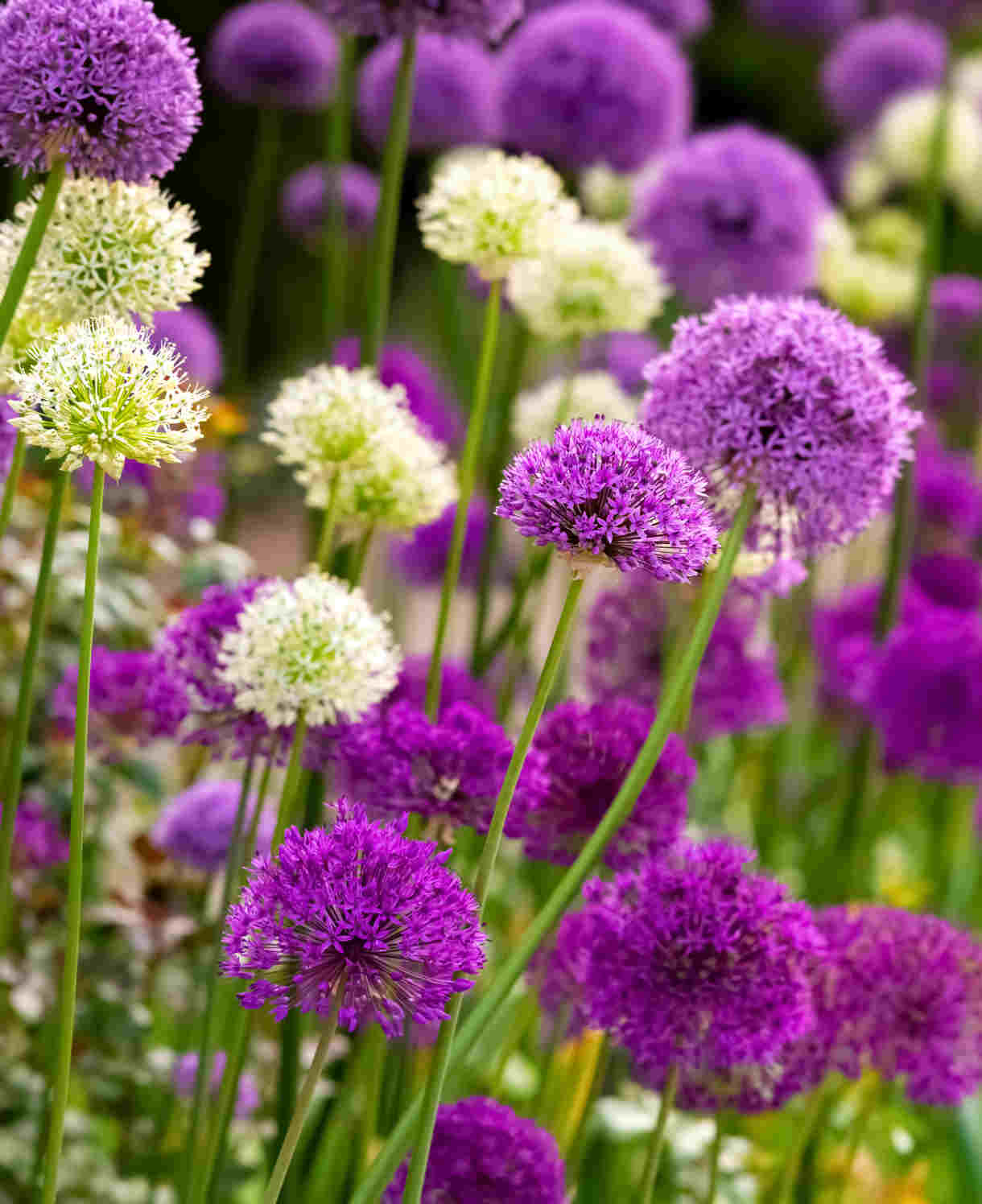

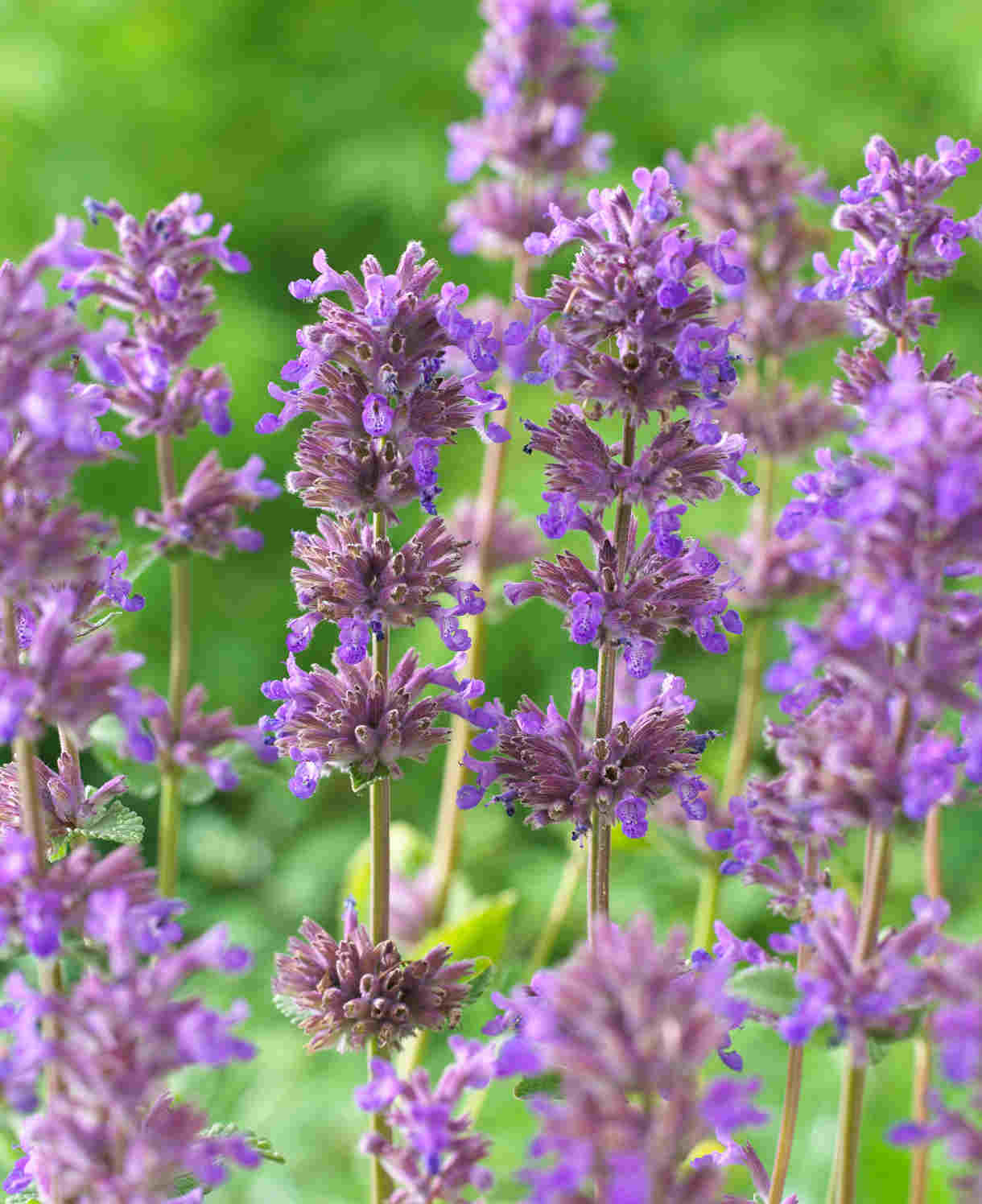
How to care for Laburnum
Pruning and Deadheading
Remember to wear gloves when handling any part of laburnum.
Laburnum falls into RHS pruning group 1, which means no pruning is required if being left to grow freely as a specimen tree other than the occasional removing of dead, diseased, damaged, or badly placed growth. This is best done between late summer and Christmas; laburnum is likely to bleed sap if pruned in spring or early summer.
Some laburnum cultivars may be grafted onto the rootstock of another species. If this is the case, remove any shoots arising from below the graft union whenever you spot them.
If you’re training a laburnum, the shoots will need to be tied in and trimmed as follows:
- Tie main shoots to the support throughout the growing season.
- Until the main framework is established, trim the main shoots back by a third between the end of summer and midwinter. This will encourage bushiness and therefore a dense coverage of the support. Any unwanted shoots can be cut back to three to four buds.
- Continue to do this until the framework is established. After this, simply shorten back all shoots annually to retain the shape.
Watering
Like all woody plants, laburnum does best with regular watering for its first couple of growing seasons in the ground to encourage root establishment. After this it should be largely self-sufficient, though it still pays to water in prolonged periods of hot, dry weather. An annual mulch is also useful for locking in moisture – more on this in our ‘Feeding’ section below.
Container-grown laburnum needs regular watering throughout every growing season. Aim for infrequent big soakings, rather than little and often, allowing the top few centimetres of compost to dry out each time, though be aware that container-grown trees can dry out very quickly during the height of summer and sometimes need watering as often as every day. From mid-autumn, the British climate tends to take over watering needs, though do remember to step in in the event of an unseasonably dry spell.
Feeding
On healthy, fertile soil, an annual mulch of well-rotted organic matter should provide sufficient nutrients for your laburnum. This has the added benefit of suppressing weeds and locking in moisture. Autumn or spring are the best times to carry out mulching.
For an extra boost (most needed in the first few years of the plant being in the ground, or annually if growing in poor soil), apply a general-purpose granular feed or blood, fish, and bone to the surface of the soil and lightly work it in. This is known as a ‘top dress’ and is best done in late winter or early spring.
Container-grown plants rely more on the gardener for nutrition. Get off to a flying start by making sure you use a good quality potting compost, then throughout the growing season (March to September) apply a liquid feed every 3-4 weeks. Remember to repot into a slightly larger pot with fresh compost every few years. Once the plant is in the largest container possible and this is no longer feasible, an annual topdress is advised. Each spring, scrape away the top 5cm of compost and replace with fresh, remembering to mix in a little general-purpose slow-release feed.
Cold Protection
Laburnum is hardy enough to withstand even a harsh UK winter without the need for additional protection. Having said this, flower buds can be damaged by a late frost, so where possible try to plant in a sheltered spot. Otherwise, young or small trees can be protected by one of these handy fleece jackets, a layer of horticultural fleece, or old bedsheet. Mature specimens can be harder to protect; though you could take inspiration from RHS Wisley, where the garden team stoke nighttime fires beneath the laburnum arch whenever a late frost is forecast.
Pests and Diseases
Laburnum is a relatively problem-free tree, though you may spot the work of the laburnum leaf mining moth. In its caterpillar form this can cause unsightly blotches on the leaves, though rarely affects the overall health of the tree. Tolerate if you can, leaving natural predators such as blue tits to keep numbers down.
Other potential pitfalls include honey fungus (mercifully rare unless you’re near a heavily wooded area), blackfly, and powdery mildew. While there’s little you can do to avoid honey fungus, the effects of blackfly and powdery mildew can be mitigated by growing as healthy and thriving a tree as possible. This means planting it in the right conditions, keeping it watered until fully established, and mulching annually. Encouraging a balanced garden ecosystem also helps control pest numbers. This can be done by limiting your use of chemicals, feeding birds, planting a rich and diverse range of plants, and leaving some areas a little more ‘wild’ to provide a habitat for wildlife.
How to propagate Laburnum
Laburnum can be propagated by hardwood cuttings, taken from late autumn to early winter:
- Choose a shoot of fully ripe, current year growth and cut just above a bud.
- Select a healthy and firm section of the stem and trim to 15-20cm, with the top cut just above a pair of buds, and the bottom cut just below a pair of buds. It is good practice to make the top cut a sloping one, both to aid water runoff, and to remind you which end is which! Upside down cuttings have no chance of rooting.
- Spacing approximately 10-15cm apart, firm into a trench in a prepared bed outside (with well-rotted organic matter and grit dug in), the top 3-5cm of the cutting showing above soil level. Alternatively insert into containers filled with a gritty compost mix.
- Water in lightly. Place containers in a cold frame or unheated greenhouse.
- Check and re-firm trench cuttings after a frost (which can lift them out of the ground).
- Leave cuttings in place until the following autumn ensuring they do not dry out during the summer. By this point they should have rooted and can be lifted and either potted or planted out as required.
* Many plants carry Plant Breeders Rights and cannot be propagated for commercial purposes.
Common Laburnum questions
How quickly does laburnum grow?
This is a fast-growing tree which can be expected to put on around 40 centimetres per year.
How do you grow a laburnum arch?
The most important advice here is to start with a sturdy, metal framework, as a mature laburnum is heavy, especially when laden with flowers. Aim for a height of around 2.4 metres, and certainly don’t go any lower than around 2.1 metres, as this would make passing beneath impossible when the plant is in bloom. A width of 2 - 3 metres is ideal.
Space plants 2 - 2.4 metres apart, then train as explained above, firstly in ‘How to plant laburnum’, then in ‘Pruning and Deadheading’.
Is laburnum related to wisteria? They look very similar.
Yes, both belong to the pea or legume family (fabaceae).
The flowering of my laburnum seems rather erratic. Is this normal?
Some laburnums can flower heavily one year, then less abundant the next. This is entirely normal and nothing to worry about.
